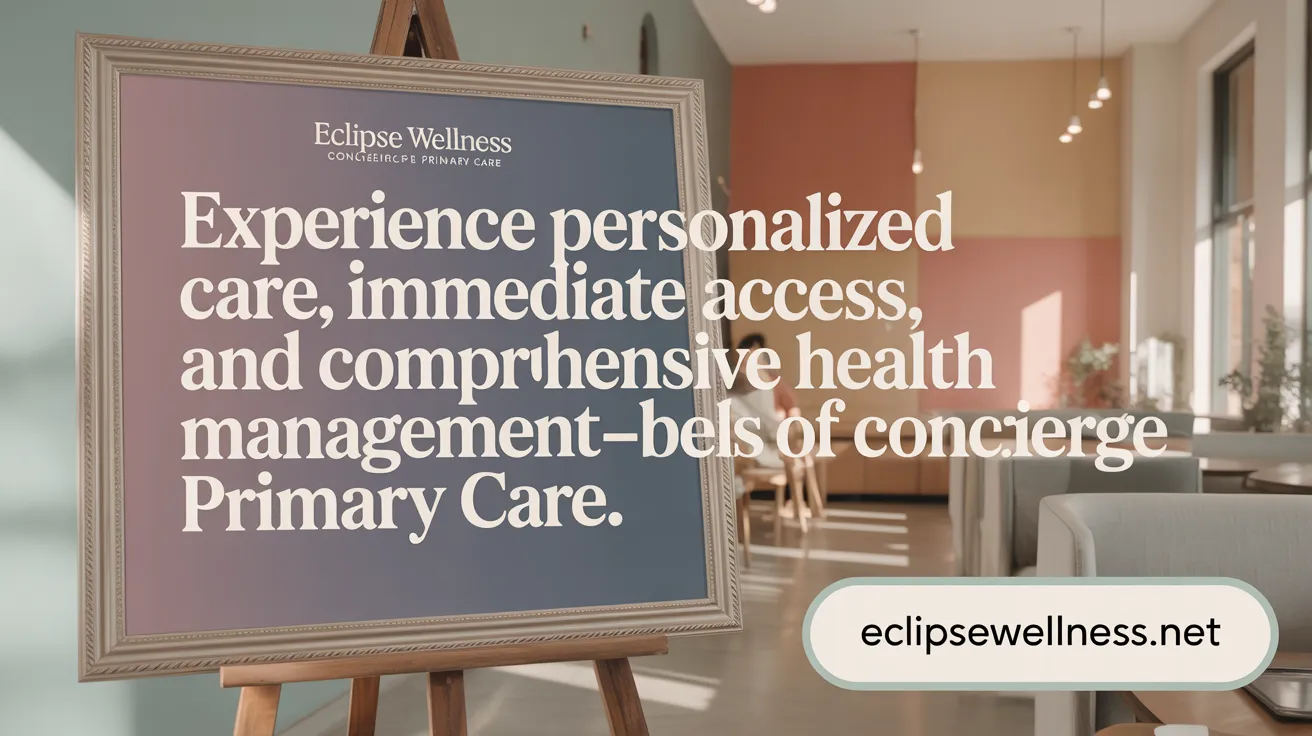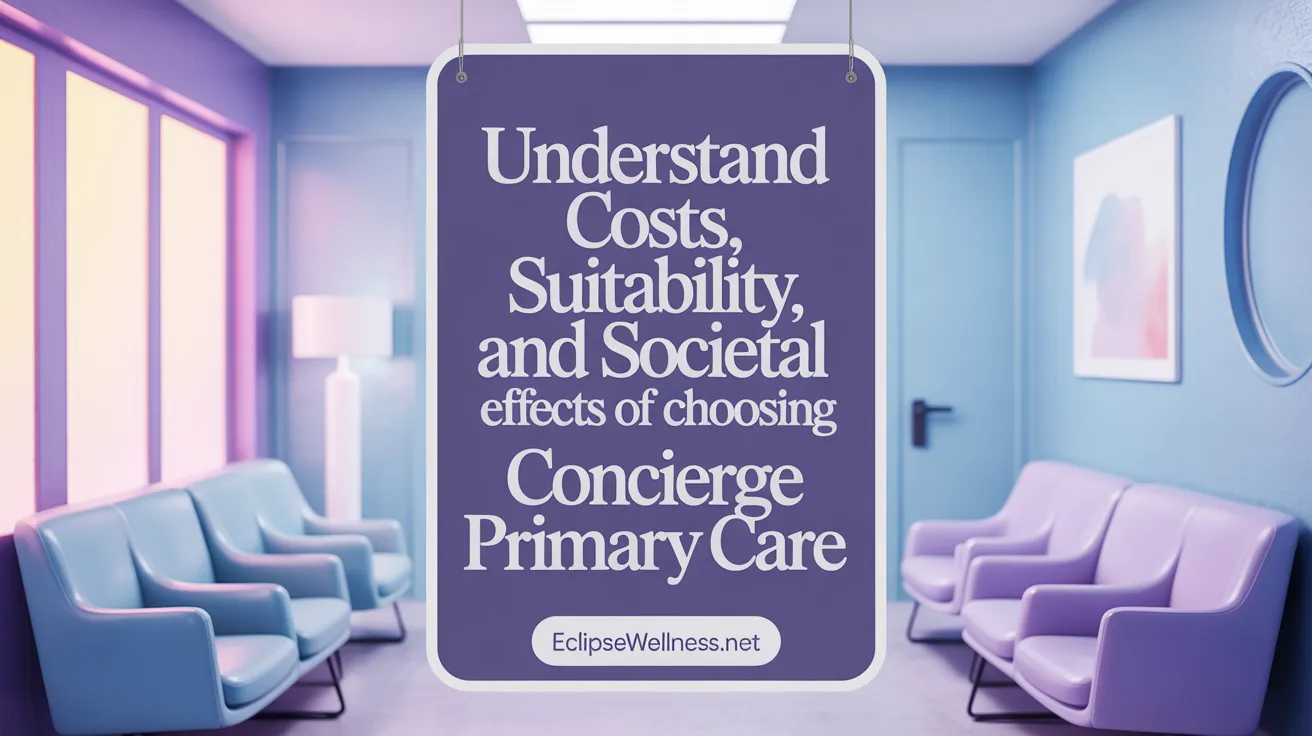Discover the Essence of Concierge Primary Care
As healthcare evolves, concierge primary care has emerged as a transformative model promising personalized, accessible, and high-quality medical services. This article explores why more patients and physicians are opting for this membership-based approach, highlighting its unique features, benefits, and considerations, and illustrating how it can reshape your healthcare experience.
Understanding Concierge Primary Care: A New Paradigm in Healthcare

What is concierge primary care and how does it differ from traditional primary care?
Concierge primary care is a healthcare model where patients pay an annual or monthly membership fee to access personalized, high-quality care. This fee often covers longer appointments, generally lasting from 30 to 90 minutes, and provides patients with direct, around-the-clock communication with their physicians via phone, text, or email. Patients in concierge practices typically benefit from quicker appointment scheduling, often same-day or next-day, and additional services like health coaching and preventive screenings (Concierge Medicine Benefits, Concierge Medicine Explained).
Traditional primary care, on the other hand, mainly relies on insurance billing and serves larger patient populations—often between 2,000 and 4,000 patients per doctor. Consultations are shorter, usually around 15 minutes, and access to physicians outside scheduled visits is limited. This model tends to prioritize volume over personalized services, which can lead to longer wait times and less individualized attention (Concierge Service model, Concierge Medicine pros and cons).
In essence, concierge primary care emphasizes a proactive, patient-centered approach, fostering stronger relationships and offering more comprehensive care. It targets individuals willing to invest more in their health for enhanced access, better preventive care, and a more tailored healthcare experience, contrasting sharply with the more reactive, insurance-dependent traditional primary care (Personalized Care in Concierge Medicine, Concierge Medicine Patient Experience).
The Distinct Advantages of Concierge Primary Care
 Choosing concierge primary care provides several notable benefits that enhance the overall healthcare experience. Patients enjoy highly personalized and longer appointments, allowing doctors to spend more time understanding their health history, lifestyle, and concerns. This detailed interaction fosters a stronger, more trusting relationship between patient and physician, which is crucial for effective preventive care and managing chronic conditions.
Choosing concierge primary care provides several notable benefits that enhance the overall healthcare experience. Patients enjoy highly personalized and longer appointments, allowing doctors to spend more time understanding their health history, lifestyle, and concerns. This detailed interaction fosters a stronger, more trusting relationship between patient and physician, which is crucial for effective preventive care and managing chronic conditions.
Immediate access and seamless communication are significant advantages. Many concierge practices offer same-day or next-day appointments, and patients can often contact their doctor via phone, email, or text 24/7. This quick accessibility enables timely advice during urgent situations, reducing unnecessary emergency room visits and providing peace of mind.
Another key benefit is the increased focus on comprehensive care coordination, Concierge physicians often handle referrals to specialists, coordinate treatments, and actively follow up on health issues, ensuring a smooth and integrated healthcare journey for patients.
Additionally, concierge practices often include amenities that elevate comfort and convenience, such as private waiting rooms, virtual consultations, and personalized health programs. These features support a proactive approach to health, emphasizing prevention, lifestyle management, and wellness optimization.
While this model brings significant advantages, it generally involves higher costs, typically through annual membership fees, which may limit accessibility for some populations. Despite this, many patients, especially those seeking dedicated, detail-oriented healthcare, find substantial value in the personalized, accessible, and comprehensive approach offered by concierge primary care.
How Concierge Primary Care Elevates Patient Experience and Outcomes
How does concierge primary care improve patient experience and health outcomes?
Concierge primary care significantly enhances the overall patient experience through various tailored and accessible services. Patients benefit from longer appointment times, often 30 to 60 minutes, which allows for thorough discussions of health concerns and personalized care plans. This personalized approach fosters stronger relationships between patients and their healthcare providers, resulting in increased trust and satisfaction.
In addition, many concierge practices offer 24/7 direct access to their physicians via multiple communication channels, such as phone, email, text, and video. This immediate or rapid availability ensures that patients can seek advice or urgent care quickly, often avoiding unnecessary trips to emergency rooms. The model also emphasizes continuity of care, with providers often coordinating care with specialists and managing referrals seamlessly.
One of the main benefits of concierge care is its proactive focus on chronic disease management and preventative health measures. With ample time and resources, doctors can perform comprehensive screenings, lifestyle assessments, and personalized wellness programs, leading to early detection and better control of chronic conditions like diabetes or hypertension.
Research indicates that this high level of personalized attention correlates with higher patient satisfaction, increased engagement in health management, and better adherence to treatment plans. Although concrete data on long-term health outcomes is still emerging, initial evidence suggests that patients in concierge models experience fewer hospitalizations and health complications.
In summary, concierge primary care's combination of extended, personalized consultations, continuous availability, and coordinated care improves both the patient experience and health management, promoting better overall health. Ongoing studies continue to explore its full impact, but current findings support its role in fostering proactive, patient-centered healthcare.
Core Services and Structure of Concierge Primary Care Models
 What services are typically offered within concierge primary care models?
What services are typically offered within concierge primary care models?
Concierge primary care models are designed to provide highly personalized, comprehensive healthcare services tailored to individual patient needs. These services usually include preventive care, such as regular health screenings and wellness exams, as well as diagnostic testing like blood work, EKGs, and imaging. Patients also benefit from personalized management of chronic conditions, with longer, in-depth consultations often lasting 30 to 60 minutes, allowing physicians to thoroughly discuss health histories, lifestyle factors, and preventive strategies.
In addition to routine primary care, concierge practices often offer same-day or next-day appointments, which dramatically reduce wait times. Patients gain 24/7 direct access to their physicians through various communication tools such as secure messaging, phone calls, and virtual visits, supporting immediate consultations outside normal office hours. Wellness programs, nutrition advice, and health coaching are frequently integrated to promote proactive health management.
These practices typically operate with small patient panels, usually between 300 to 600 patients per physician, fostering closer doctor-patient relationships and continuous care. Additional services may include travel medicine, urgent care, in-house diagnostic services, and coordination of specialist referrals to ensure seamless treatment. Most concierge services are paid through membership or retainer fees, often ranging from $1,500 to $10,000 annually, and these fees generally do not cover hospital stays or specialist treatments, which remain billed through insurance.
What is the structure and key features of the concierge healthcare model?
The core structure of concierge healthcare revolves around a membership or retainer fee system that emphasizes exclusivity, personalized attention, and accessibility. Patients pay an annual fee—sometimes monthly or quarterly—to secure enhanced services, including longer appointments, immediate availability, and direct communication with their physicians via phone, email, or secure messaging platforms.
Physicians practicing in this model typically limit their daily patient load to around 300 to 600 patients, compared to thousands in traditional practices. This limited panel enables doctors to dedicate significant time to each patient, offer in-depth personalized care, and coordinate complex medical needs effectively. The model often includes benefits like same-day or next-day appointments, extended visits, and access to advanced diagnostics, some of which are available in-office to expedite care.
While many concierge practices involve paying a fee out-of-pocket, they usually accept traditional insurance for hospital stays, specialist visits, and diagnostics not covered under the membership fee. The focus is on delivering a proactive, holistic approach to health—prioritizing prevention, early intervention, and continuous relationship-building. Although the model enhances patient satisfaction and health outcomes, it also raises ethical concerns regarding access and affordability, as it tends to serve higher-income populations.
Overall, concierge medicine aims to transform healthcare into a more immediate, personalized, and collaborative experience, leveraging small panels, flexible scheduling, and integrated services to optimize health and well-being.
Financial Considerations, Suitability, and Broader Impact
 When evaluating concierge primary care options, patients should understand that Medicare typically does not cover membership or retainer fees, meaning those costs are paid entirely out-of-pocket. It’s crucial to verify whether the physician accepts Medicare — some operate under private contracts, which can influence billing practices and service access. Additionally, patients should ask about further costs for lab tests, treatments, or services not covered by Medicare, as these are billed separately. Reviewing billing policies, legal compliance, and insurance compatibility can help prevent unexpected expenses.
When evaluating concierge primary care options, patients should understand that Medicare typically does not cover membership or retainer fees, meaning those costs are paid entirely out-of-pocket. It’s crucial to verify whether the physician accepts Medicare — some operate under private contracts, which can influence billing practices and service access. Additionally, patients should ask about further costs for lab tests, treatments, or services not covered by Medicare, as these are billed separately. Reviewing billing policies, legal compliance, and insurance compatibility can help prevent unexpected expenses.
Many choose concierge care for its personalized service, longer appointments, and 24/7 access, which often leads to higher satisfaction and better health management. Physicians value this model because it allows for more meaningful patient relationships, less burnout, and advancements in comprehensive care, including wellness and preventative strategies.
Compared with models like direct primary care (DPC), concierge practices typically involve higher fees — often from $1,500 to $10,000 annually — and offer a broader array of premium services, including extensive diagnostics and around-the-clock access. DPC, with its lower cost and focus on routine primary care, suits individuals seeking affordable, accessible care, whereas concierge models cater to those who prioritize luxury, comprehensive service, and immediate availability.
However, the widespread adoption of concierge medicine can have substantial effects on the healthcare system. It may exacerbate disparities, as high costs restrict access mainly to affluent populations, possibly creating a two-tier system. It can also contribute to primary care shortages as more experienced physicians shift toward concierge practices due to better income and work conditions.
This model is generally best suited for individuals managing chronic conditions, seeking extensive preventive care, or valuing immediate access. While it enhances patient experience and outcomes at the individual level, its societal impact raises important questions about fairness, equitable access, and system sustainability. Ultimately, prospective patients should weigh their health needs and financial situation carefully to determine if concierge primary care aligns with their goals.
Considering Concierge Primary Care for Your Health Journey
Concierge primary care offers an inviting alternative to traditional healthcare through its personalized, accessible, and proactive approach. By fostering meaningful patient-physician relationships, enabling immediate access, and emphasizing preventive care, it addresses many shortcomings of conventional primary care. However, its higher cost structure and potential equity challenges require thoughtful consideration. For those seeking comprehensive, tailored healthcare with a focus on long-term wellness and are able to afford the membership, concierge primary care may significantly enhance health outcomes and patient experience. As this model continues to evolve, it highlights an emerging future for primary care centered on personalization, quality, and accessibility.
